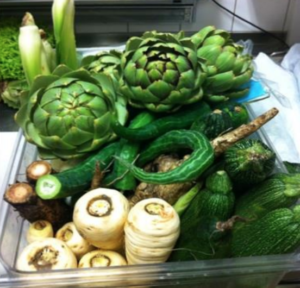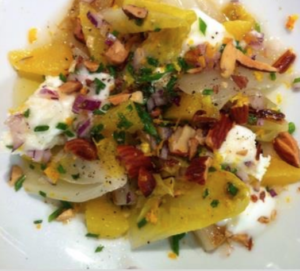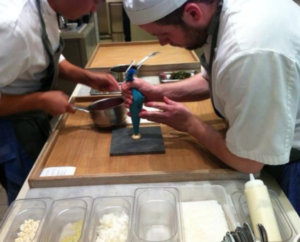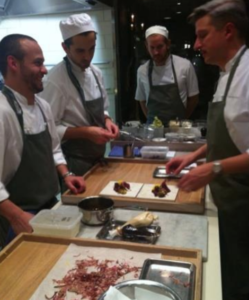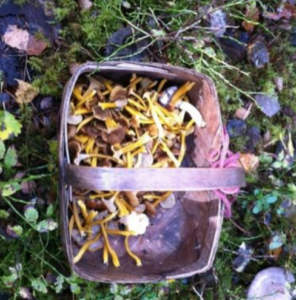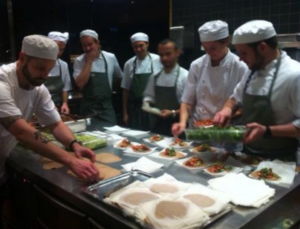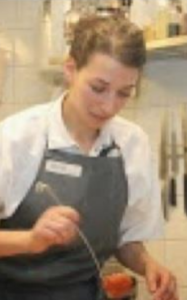
I have had a phenomenal experience in Stockholm. From the wild mushrooms to the shellfish, to the aged mountain cows, to traditional ättiksprit pickling methods, to widespread consumption of fish eggs for breakfast, brown butter, gräddfil, cheese pies, langoustines and reindeer, Jerusalem artichokes in place of potatoes, blueberries sweetened by night-less summers, lamb fat richly flavored by mossy grass, to the youthful and emerging Stockholm restaurant culture, Sweden has a rich and tangible culinary character. I am grateful to the Bocuse d’Or USA Foundation for the opportunity to immerse myself in this new culture.
What made you want to Stage in Sweden?
I chose to stage at Restaurant Frantzén upon a suggestion from Chef Gavin Kaysen, as we were discussing options for how to make the best use of my scholarship opportunity. I decided to use the scholarship to explore two kinds of restaurants: a classically-based three-star kitchen in France, and a more modern, avant garde one elsewhere. This division of time made sense due to my lifelong attraction to classical French technique and a desire to engage with the origins of the craft, which drives the practices of so many American kitchens today. My charcuterie training at Gramercy Tavern fed this desire as did my deep research into the origins of poulet au vinaigre recipes, while training for the Commis Competition. It made sense to contrast this classical experience with something radically different, in a less familiar place. The trendy and avant garde were not my natural inclination, but knowing the importance of pushing oneself in less comfortable directions as a catalyst for growth, I went for it nonetheless.
For the less traditional option, Chef Kaysen suggested Restaurant Frantzén (at the time called Frantzén/Lindberg) as an up-and-coming restaurant in the New Nordic cuisine movement which had received significant international recognition and accolades over the past few years. Though Restaurant Frantzén is a two-star restaurant, I was excited to experience a younger, rapidly evolving kitchen where the team is still forming their identity and pushing hard for that third star. Reading about Chef Bjorn Frantzén, I felt drawn to the structure of an ever-changing, hyper-seasonal tasting menu. I was attracted to Frantzén’s approach to ingredient hunting, the garden-driven menu, the commitment to the reclamation of indigenous Swedish ingredients, and to the seemingly extreme a la minute approach to service (for example, presenting the guest with a live langoustine, before serving it as a tartar). I was also attracted to the small kitchen, especially in contrast to Gramercy Tavern, where I had been working the past few years, and I looked forward to the challenges of adaptation to such a different environment. I was intrigued by the French and Japanese influences on Bjorn Frantzén’s work, particularly from the time he spent training at L’Arpege. I looked forward to observing the influence of Alain Passard and contemporary vegetable-centric French cuisine in the hands of young Swedish chefs in a Scandinavian context, and I hoped to gain some insight into the relationships between these two movements.
Can you describe what you did during your Stages?
Within my first week I was assigned to my own station, and given full responsibility for the mise en place and plating of a signature vegetable dish, the Satio Tempesta. The Satio is a composed “salad” of 37 - 45 different ingredients changing daily to epitomize and exemplify the seasonal bounty of that moment (something of Bra’s Gargouillou, yet Swedish). While deeply immersed in daily vegetable preparation for the Satio, I had the great fortune to visit the garden in Malmköping where much of Frantzén’s produce is grown, and to learn about gardener Jan Andersson’s growing techniques for maximizing flavor in plants. In my second month at Frantzén, I was promoted to the “pass” station, where I was trained to be one of two cooks plating directly in front of the guests at the “Bar” next to our head chef Jim Löfdahl, who talks the guest through each dish. This experience illuminated for me the unique sense of magic that occurs for the diners when chefs are interacting so closely with them.
Restaurant Frantzén is a special restaurant that creates an extraordinary experience for its guests. I greatly appreciate having the opportunity to work there. However, the finesse demonstrated in the dining room, did not exactly match the style of daily operations in the kitchen. I expected and desired a more professional structure and challenge than were offered there. In early October I moved on to Mathias Dahlgren, with the recommendation of Frantzén’s Head Chef and Sous Chef, and on friendly terms with all of their staff. This ended up being a really good decision.
Mathias Dahlgren is a truly excellent restaurant, and Chef Dahlgren (BDO winner 1997) himself is an engaged and engaging chef who is present in his own kitchen almost every day. I am so impressed with the way this kitchen operates. Extremely efficient and extremely well-designed, it produces honest, thoughtful food of elegant, consistent quality. Mathias Dahlgren’s food has a more serious focus on flavors, tastes and textures than on showiness or storylines. This restaurant emphasizes creating a delicious experience, more than an ‘interesting’ one. I resonate strongly with the food here and have been learning so much each day from the high level of professionalism I am immersed in. The chefs are focused, well-trained and impressively organized. Each chef demonstrates a sense of ownership, responsibility and pride in her or his work. There is strong leadership, as well as strong cooperation. Mathias Dahlgren may be one of the nicest and most well-functioning kitchens I have ever worked in.
I was feeling so inspired by Mathias Dahlgren and enjoying living in Stockholm so much that I decided to stay until the end of January. The chefs include me in many aspects of both prep and service. I have mostly worked in the Matsalen kitchen (the more formal dining room which offers two tasting menus), but have also had the opportunity to work service and production in Matbaren (the ‘Foodbar’ which serves fantastic sharing plates à la carte in a modern bistro format). Chefs are very open to coaching the stagiaires here and embedding them in the day’s work flow. This is a teaching kitchen. I have been granted growing responsibilities and am given immediate critical feedback on my work. People here are seriously pushing, and are also really happy. I would strongly recommend Mathias Dahlgren as a place for future American chefs to stage.
What stands out as some of the lessons that you learned during your experience?
The most poignant educational gains I received from Restaurant Frantzén were exposure to new ingredients and techniques, and appreciation of the contemporary low-volume, open-kitchen, bar seat, single tasting menu restaurant model.
I have also observed some remarkable structural and cultural differences between Swedish and American kitchens. The Swedish kitchen uses a more collaborative approach. Tasks are less divided by stations and more often assigned to teams of cooks who work together to accomplish them most efficiently. The classical French brigade-based structure, and its contemporary renditions, common in New York today, are not used here. Most Swedish kitchens are simply divided into hot and cold sections. There are no "prep cooks" to do the laborious, undesirable tasks. When 10 kilos of tiny sweet shrimps arrive from Smögen three or four chefs jump on peeling them together. Line cooks, sous chefs and stagiaires alike, all peeling shrimps for 20 minutes. And then it is done. The entire team tastes and discusses new dishes together. Pastry chefs are less segregated from savory cooks than they are in the US. For example, there is no one pastry chef at Mathias Dahlgren. Daily bread-baking and dessert production are shared responsibilities amongst the kallis (cold kitchen) chefs.
I have learned that this collaborative approach benefits both the chef and the kitchen as a whole. Cooks become better versed and competent in a wider range of skills. In New York a cook would likely have to specialize in baking to obtain experience; here it is expected that anyone should be able to jump in and make consistently excellent bread. Expressing interest is all it takes to be taught something new. When a kitchen is not as heavily dependent on a single individual to accomplish each specific task, there is also a safer and more secure flow to the business. It also empowers each chef on the team to hold a collective sense of responsibility for the quality execution of everyone’s work.
One other major difference I observed in Swedish kitchens is the excellent utilization of physical space. From the placement of drains in the floors to the plastic wrap dispenser on the wall, there is nothing placed in this kitchen that you wish were elsewhere. Never before have I felt such an awareness of how the physical layout of the space in a kitchen can directly support or hinder the success of its chefs. Experiencing this superior Scandinavian design was one of the most eye-opening realizations I had working in Sweden.
Another pleasure of working in Sweden has been learning more about the Bocuse d’Or in a culture where both chefs and civilians are better versed in the meaning of the Bocuse d’Or. It has more palpable presence in kitchens here. For example, within a few weeks of living here, I became acquainted with two former commis of previous candidates, one Swede and one Norwegian. More than half of the chefs I have met have personal connections to the Bocuse d’Or. Either they or one of their colleagues have competed, used to work for a candidate, or been involved in the Swedish National Team. It is common to make reference to the Bocuse d’Or in everyday kitchen life. And my friends and colleagues are all excited about the upcoming European competition taking place in Stockholm in May.
This enthusiasm is perhaps symptomatic of a smaller country and much smaller community of chefs than we have in the US, but it also opened my eyes to the deeper roots the Bocuse d’Or has grown in Scandinavian culture. A strong sense of national and regional culinary identity is easier to describe and manifest here, both in competition and on plates of a restaurant menu. The specificity of place, time, and regional ingredients is easier to define here than the broad and elusive “American cuisine”. I now more thoroughly understand some of the unique challenges the US team faces in the Bocuse d’Or. At the same time, I am excited to be a part of the generation of chefs that takes on and conquers the challenge of defining America’s culinary identity on the global stage.
It has been extremely inspiring for me to live and work in a culture that values the Bocuse d’Or. This experience has not only affirmed my commitment to support the mission of the Bocuse d’Or USA Foundation, it has also affirmed my personal desire and intention to compete as a future American Bocuse d’Or candidate. I have managed to live quite well on a strict and very lean budget the last six months. I was fortunate to receive an invitation to live with a family, in a city notorious for the shortage of affordable housing. It would have been rather difficult to find long term housing on my budget, if I had not been blessed with this personal connection. Most other stagiaires I have met along the way were staying either at hostels or with friends. Discipline and desire helped me put half my scholarship funds away untouched, with the intention of using that money to support myself during my stage in Paris. My experiences in Sweden have only clarified and reinforced my desire to cook at an even higher level.
I cannot adequately describe in one essay what an eye-opening, life-changing experience I have had so far. Competing in the Commis Competition, traveling to Europe, and becoming a part of new food cultures and new kitchens, have ignited an insatiable hunger in me for learning, for culinary excellence and for winning, which I did not know before. This experience is undoubtedly having a formative impact on my career and on my evolution as a chef. This scholarship has succeeded in "inspiring culinary excellence" in my life and I hope in the lives of everyone with whom I share this story and this journey. I do not want to keep this privilege to myself. I strongly encourage The Foundation to provide more opportunities like this for my peers.
Photos from Rose's stage:
